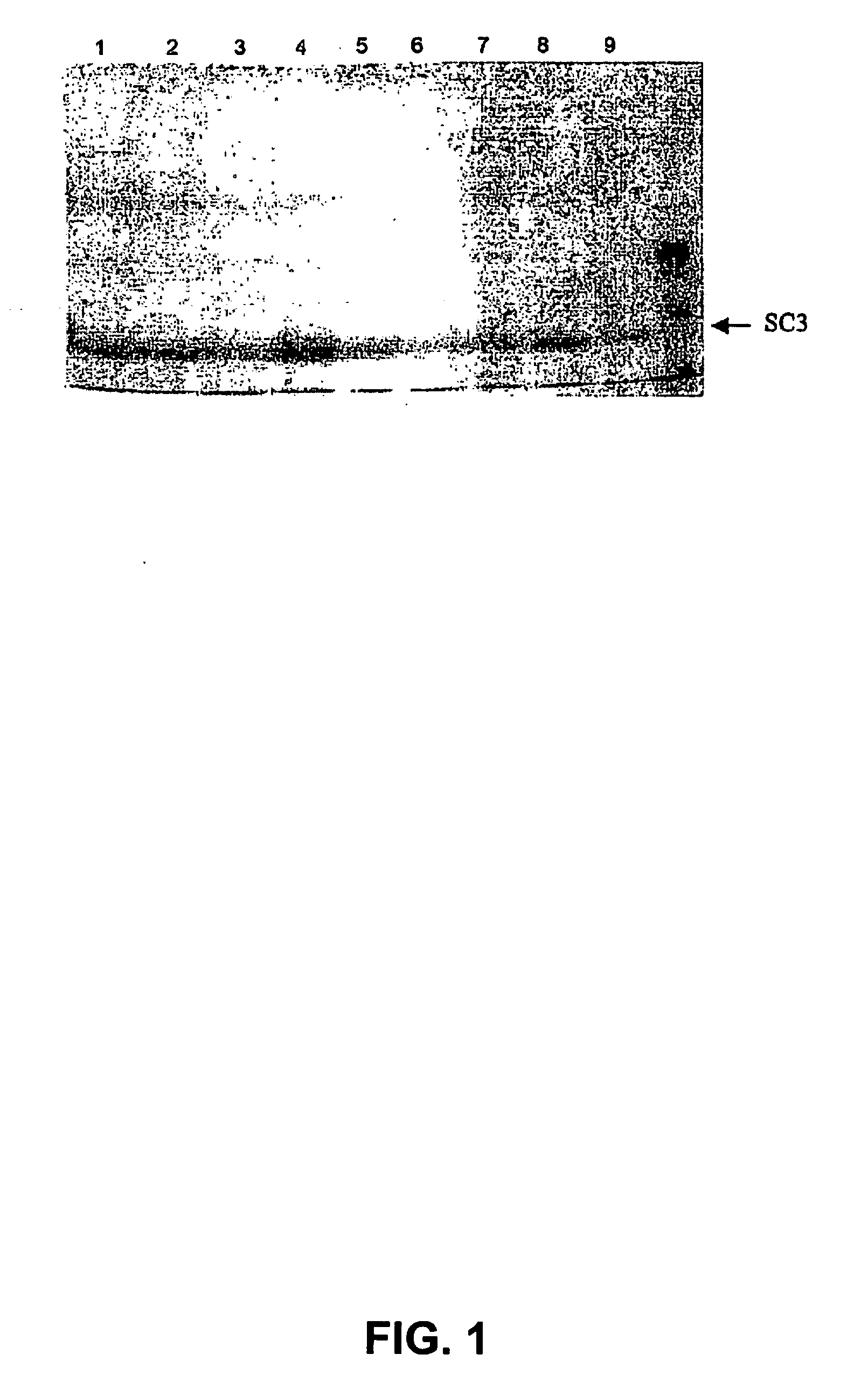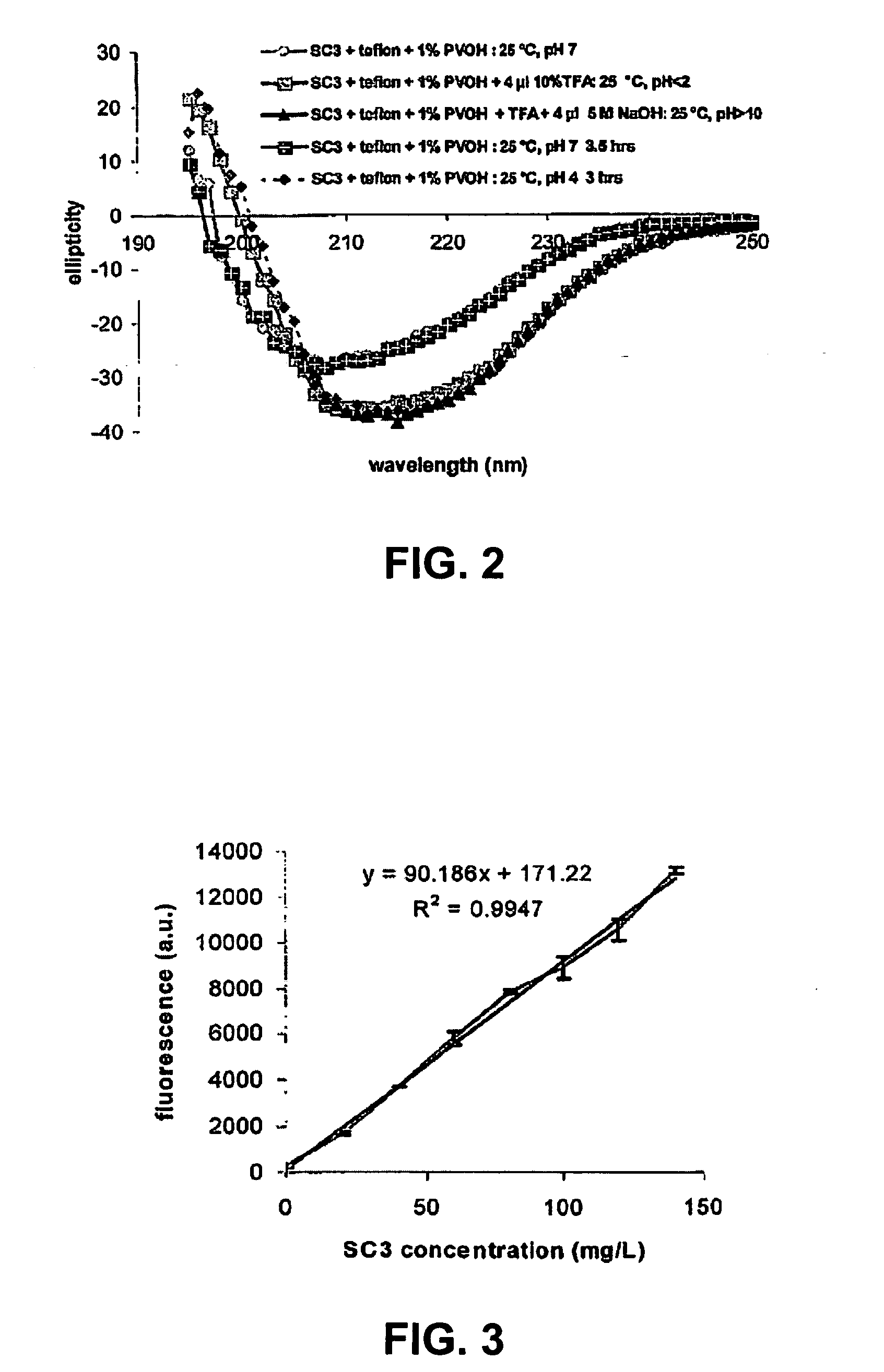Method for coating an object with hydrophobin at low temperatures
a hydrophobin and low temperature technology, applied in the field of hydrophobin stabilization methods, can solve the problems of high heat treatment cost, unattractive heat treatment, and inability to stabilize the hydrophobin molecules, and achieve the effect of high contact angl
- Summary
- Abstract
- Description
- Claims
- Application Information
AI Technical Summary
Benefits of technology
Problems solved by technology
Method used
Image
Examples
example 1
Soluble State of SC3 in Culture Supernatant of S. commune Containing the Detergent PVOH
[0052] 200 ml cultures of S. commune (ΔSC15) were inoculated by fragmenting one-half of a colony in 40 ml production medium (PM) using a WARING blender. Two ml of the fragmented material (macerate) was added to 200 ml PM in a 1 L Erlenmeyer flask. Similarly, two cultures with 200 ml PM containing either 0.1 or 0.3% PVOH were inoculated. The cultures were grown at 30° C. and 200 rpm. The cultures were harvested at a glucose concentration of below 5 g / L. The culture supernatant was obtained by separating the medium from the mycelium by filtering over a nylon cloth. Analysis of the production levels of the hydrophobin SC3 by SDS-PAGE and Coomassie-staining of 450 μl 10% TCA precipitated medium showed that the amount of SC3 produced in the culture containing 0.1% PVOH was similar to that in the cultures grown without PVOH (FIG. 1, lanes 1 and 2). In the 0.3% PVOH-containing culture, SC3 production wa...
example 2
Coating with Culture Supernatant—Contact Angles of PTFE-Sheets Coated in Culture Supernatant Containing PVOH
[0054] PTFE (polytetrafluoroethylene; PTFE) sheets of 2 cm2 were thoroughly cleaned with 100% ethanol, pure TFA and washed with water. PTFE sheets were placed in 2 ml containers containing 2 ml of culture supernatant without PVOH and supernatant with 0.1%-2% PVOH present during growth, such that a layer was formed on the surface of the sheet. The supernatants were obtained as described in Example 1. A hydrophobin layer was prepared by incubation for 16 hours at 25° C. in supernatant (pH 5.5) or in supernatant that was acidified to pH 2 with TFA or HCl. The coated sheets were washed three times for five minutes with milliQ water and were left to dry. The hydrophilicity of the coated surface was determined with a Drop Shape Analysis System DSA 10 Mk2 apparatus (Krüss) by measuring the contact angle of 1-2 μl milliQ water with the surface.
[0055] The results show that culture su...
example 3
Coating an Object with Hydrophobin by Exposure to a Low pH in the Presence of a Detergent CD Experiments, Varying Conditions, Detergent and Time Course
[0058] The secondary structure of SC3 was studied with circular dichroism spectroscopy (CD). The CD spectra were recorded over the wavelength of 190-250 nm on an Aviv 62A DS CD spectrometer (Aviv Associates, Lakewood, N.J., USA), using a 1-mm quartz cuvette. The spectra were recorded using a reference solution without protein. Typically, a protein concentration of 100 to 200 μg / ml was used. For spectra of hydrophobin bound to a hydrophobic support, 159 nm non-stabilized, colloidal polytetrafluoroethylene (PTFE) in water was added to the solution. Surface coverage of hydrophobin on PTFE was typically 10%. As detergent, 1% polyvinyl alcohol (w / w; PVOH, 88% hydrolyzed) or 0.1% TWEEN 20 were used as a final concentration.
[0059] A) 100 μl SC3 (0.5 mg / ml) in 25 mM phosphate buffer (pH 7.0), 200 μl 2% PVOH (w / w), and 100 μl colloidal PTFE ...
PUM
| Property | Measurement | Unit |
|---|---|---|
| Temperature | aaaaa | aaaaa |
| Temperature | aaaaa | aaaaa |
| Temperature | aaaaa | aaaaa |
Abstract
Description
Claims
Application Information
 Login to View More
Login to View More - R&D
- Intellectual Property
- Life Sciences
- Materials
- Tech Scout
- Unparalleled Data Quality
- Higher Quality Content
- 60% Fewer Hallucinations
Browse by: Latest US Patents, China's latest patents, Technical Efficacy Thesaurus, Application Domain, Technology Topic, Popular Technical Reports.
© 2025 PatSnap. All rights reserved.Legal|Privacy policy|Modern Slavery Act Transparency Statement|Sitemap|About US| Contact US: help@patsnap.com



